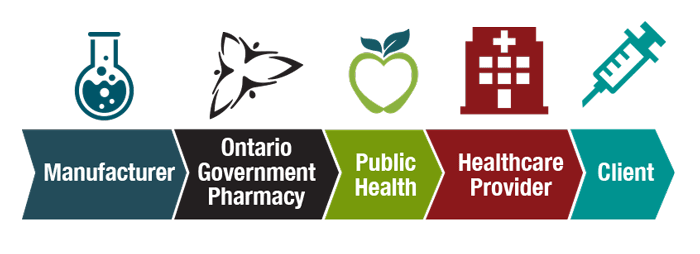Public Health inspects every location where provincially funded vaccines are stored. These include doctor’s offices, hospitals and pharmacies. These efforts ensure the delivery of safe, effective vaccines.
Vaccines can be damaged if exposed to temperatures below 2°C or above 8°C. The “cold chain” refers to a vaccine maintaining this temperature beginning at the manufacturer and ending when the vaccine has been administered to the client.

Public Health’s role
- Train healthcare professionals on how to monitor and store their vaccines
- Investigate cold chain incidents to determine the cause and whether the vaccine should be used or returned to Public Health
- Provide follow-up education and resources to prevent future incidents and ensure that adequate cold chain conditions are maintained
Healthcare provider’s role
- Ensure the temperature of your vaccines is maintained between 2°C and 8°C at all times during transport, storage and handling
- Report cold chain incidents (temperatures outside 2-8°C) immediately to the cold chain nurse at 1-800-265-7293 ext. 4500
- Have a dedicated vaccine fridge that can maintain temperatures between 2°C and 8°C
- Have a digital min/max thermometer (glycol recommended) and monitor your vaccine fridge temperatures twice daily
- Record the date, time, minimum, maximum and current temperature in the Temperature Log Book twice daily
- Transport vaccine under cold chain using an insulated cooler, ice packs from freezer, refrigerated flexible gel blankets and a digital min/max thermometer
Resources to help you store and handle vaccines safely
Roles and Responsibilities template
Establishing clear roles and responsibilities for each staff member involved in the storage and handling of publicly funded vaccines in crucial to successfully maintaining the cold chain.
Orientation Checklist
An opportunity to standardize your training on vaccine cold chain management; outlines actions to take to ensure you and your staff know the importance of cold chain and the policy and procedures.
Maintain the Chain Flipbook
A quick reference for vaccine storage and handling.
Incident Checklist and Incident Description Form
A step-by-step guide of what to do if your facility has a cold chain incident.
Vaccine Inventory Form
Used when a cold chain incident occurs; we require an inventory of all your publicly funded vaccines in order to contact the vaccine manufacturers.
Vaccine Temperature Log Book (PDF, 20 pages, 3 MB)
Used to document the date, time, minimum, maximum, current temperature and the initials of the person documenting the vaccine temperatures (hard copies can also be requested on the Vaccine Order Form [PDF, 1 page, 243 KB] and faxed to the vaccine coordinator with your next vaccine order)
Cold chain quiz
Once you have completed the Orientation Checklist and reviewed the information provided to you on cold chain, please complete the Cold Chain Quiz.
By completing the quiz, you will assist us in evaluating our program and improving our outreach and support to you and your colleagues.
